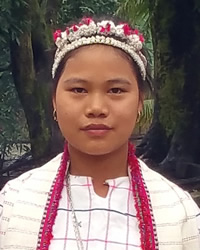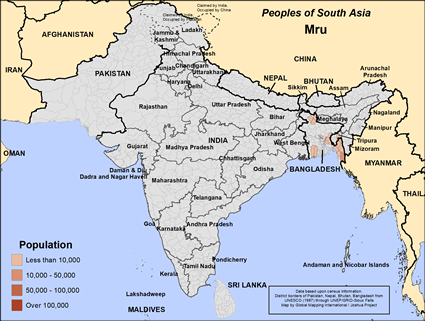The Mru are primarily located in the region where the borders of India, Bangladesh and Myanmar intersect. they are related to the Chin peoples. The tribal Mru are a very isolated people, mainly because of a national policy restricting visitors in the strategic border areas and prohibiting outsiders from obtaining land there. Some live in one of the nearly two hundred villages located in the tropical forests of the Chittagong Hills in southeast Bangladesh. Most, however, are concentrated in the plains and hills of western Myanmar's Arakan Yoma district, or in the Jalpaiguri district of northeastern India.
The language of the Mru is also called Mru. The Mru of Myanmar believe that Torai ("the great spirit") gave all peoples-except the Mru-a written language and rules to guide their social lives. They believe that by some accident, they themselves were excluded.
The Mru are farmers. They believe that a dragon causes earthquakes. When a child is born, they put bamboo on the stream bank, and they kill a chicken and put its blood on the bamboo to worship the Nats (local spirits).
A Mru son who wants to be the bridegroom talks with his father about the woman he wants to marry. Then the father, son and others go to the house of the woman he wants to be his bride. He gives items to the parents of the bride. The father talks to his daughter about her marrying him. If she agrees, there is a dowry paid. A marriage promise is allowed to be broken as long as one of them says they do not love the other.
The Mru follow Theravada Buddhism and animism. There are Christians among them as well. In the late 1990s many became Christians due to what happened when Buddhist monks tried to force Christians to become Buddhists. A thunder bolt stopped them. Then lightning destroyed a Buddhist temple. More tried to attack another Christian village and as they went on a raft, fog came. The raft was crashed into by a barge and people on the raft drowned. Many people became Christians as a result. This could help more of the Mru to become Christians when reminded of this.
Pray that signs and wonders will bring the Mru to Jesus Christ.
Pray for the Mru people to have the spiritual hunger it takes to embrace Jesus Christ no matter what the social cost may be.
Pray for loving and dedicated gospel workers.
Scripture Prayers for the Mru in Bangladesh.
en.wikipedia.org/wiki/mro_people
https://www.wikiwand.com/en/articles/Mru_people
Asia Harvest
| Profile Source: Joshua Project |












